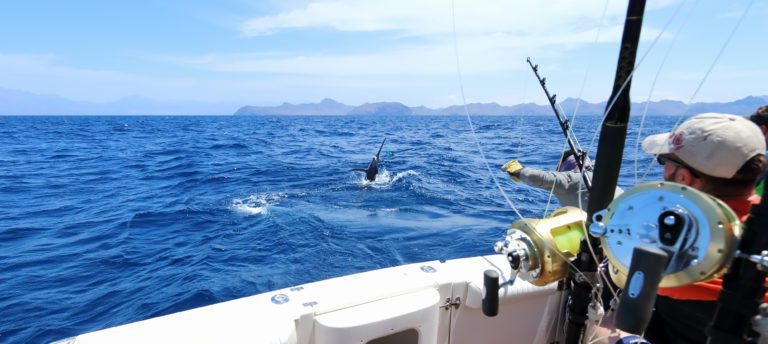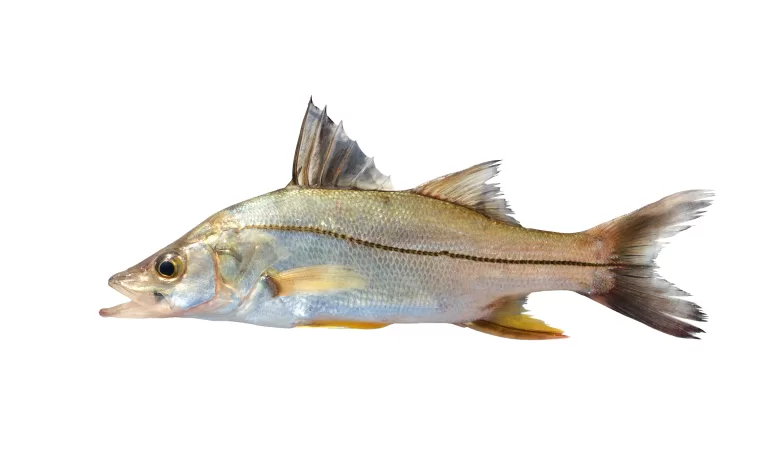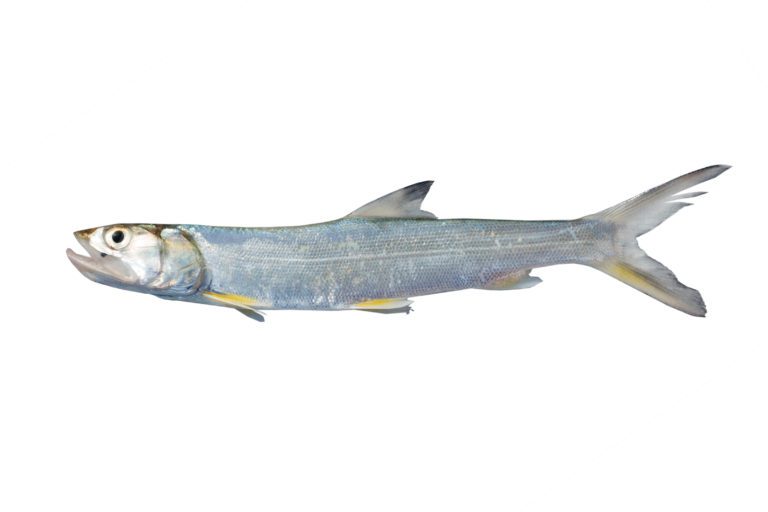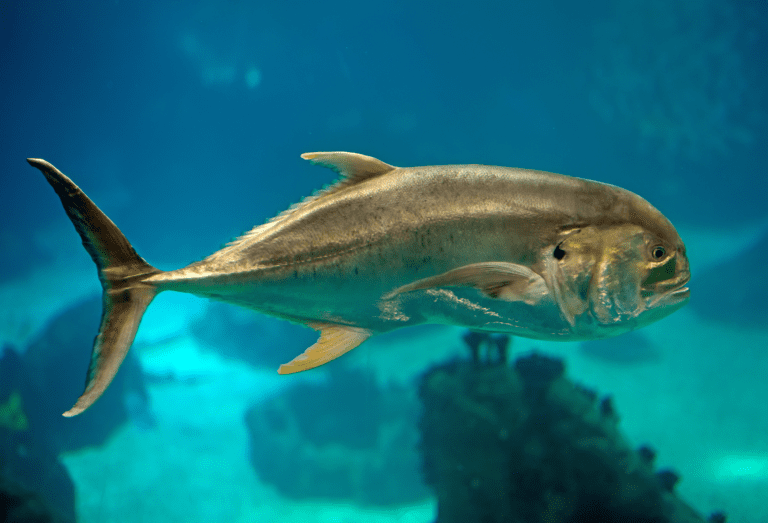Ultimate Guide to Fishing for Pompano in Florida: Techniques, Baits, and Hot Spots
Struggling to land a pompano on your fishing trips in Florida? Discover expert tips on gear, bait, and techniques in our comprehensive guide to boost your success in fishing for pompano, this sought-after species.
Key Takeaways
- Pompano are energetic saltwater fish found in Florida’s inshore waters, with migrations that make spring and winter prime times for fishing.
- The right gear for pompano fishing includes a sturdy, long rod, a size 4000-5000 spinning reel, a monofilament line with a test strength of 8-14 pounds, and size 1/0-2/0 circle hooks.
- Effective baits for catching pompano include natural options like sand fleas and shrimp, as well as artificial lures such as jigs in bright colors; the fishing technique should suit the habitat, with surf, inlet, and flats fishing being popular methods.
Getting Started with Pompano Fishing
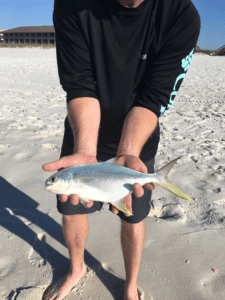
Fishing for pompano offers a unique experience that has won the hearts of many anglers. These coastal saltwater game fish are a popular catch, known for their spirited fight when hooked and their delicious taste when cooked. Pompano are found near the sand in the surf zone, making them a fantastic target for surf fishing enthusiasts.
Pompano love cooler tropical waters and sandy habitats. You’ll often find them in inshore and nearshore waters, hanging out in surf zones along beaches during the colder months of the year. A thorough understanding of pompano’s preferred habitats can enhance your fishing success. Additionally, knowing their seasonal migrations can also be beneficial in increasing your catch. During spring, pompano head north and offshore, following the warm waters. Come winter, they head back down south and closer inshore. Knowing their movement patterns can help you be in the right place at the right time to catch these feisty fish.
Essential Gear for Pompano Fishing
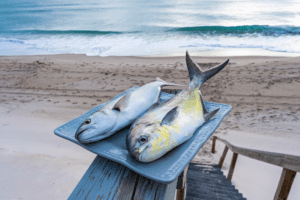
Having understood why you want to catch pompano and their locations, it’s time to discuss the necessary gear. Choosing the right equipment is a key factor in successful pompano fishing. We’ll delve into the details about:
- Rods
- Reels
- Fishing line
- Hooks
All of which play a significant role in your anglers fishing experience.
Rods and Reels
Several considerations come into play while selecting rods and reels for pompano fishing. Firstly, the length of your rod is important depending on where the pompano are. A long rod of around 10+ feet (surf casting rod) allows you to cast far, reaching those pompano schools that are way out off sandbars in the ocean. If pompano are closer to shore a 7 foot medium action rod is perfect. Pompano may be small, but they put up a good fight, so a sturdy rod is essential.
The reel accompanying your rod holds equal importance. A 4000 size spinning reel is recommended for pompano fishing. This size works great with rods that can handle casting the usual weights for pompano, making it easier to catch these delicious fish. Some popular brands among anglers are:
- Blackfin Rods
- Cabelas Fish Eagle
- Diawa Sealine
- Okuma Solaris
- Daiwa
- Shimano
These brands offer quality rods and reels for pompano fishing.
Fishing Line
Your choice of fishing line can greatly influence your pompano fishing success. For pompano fishing, it is recommended to use a monofilament line with a test strength of 8-14 pounds. This type of line provides the necessary durability and flexibility for targeting pompano. This type of line is suitable for saltwater fishing, where pompano are usually found.
But it’s not just the type and strength of the line that matters. Visibility plays a significant role too. Pompano have excellent eyesight and can get spooked by visible lines. A combination of a braided or monofilament main line with a clear monofilament or fluorocarbon leader can improve your chances of hooking a pompano. Also, consider adding a shock leader of 30 feet of 30 or 40-pound monofilament line for the best results when using a long surf casting rod. When fishing closer inshore a 1 to 2 foot 30 pound monofilament leader works fine.
Hooks and Rigs
Your success in pompano fishing can significantly hinge on the hooks and rigs you employ. For catching pompano, the best hooks to use are 2/0 stainless circle hooks or #1 or 1/0 circle hooks. These hooks work well with the preferred bait for pompano, such as sand fleas and shrimp.
Rigs in pompano fishing usually have two hooks spaced out along the leader line and a weight at the bottom to keep it steady in the surf. The most effective ones are pompano rigs, designed to present the bait effectively and can be used with clam strips, sand fleas, and small bits of shrimp or fish.
Best Baits and Lures for Pompano Fishing
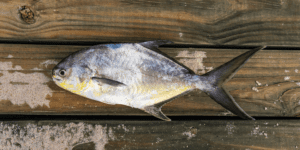
The bait and lures you use when fishing for pompano can greatly affect your success. Whether you choose natural baits or artificial lures, the key is to select something that will attract pompano effectively.
Let’s explore more about the most effective baits and lures for pompano fishing.
Natural Baits
Natural baits are a popular choice when fishing for pompano. They closely mimic the pompano’s natural diet, making them a great option to entice these fish. The best natural baits for catching pompano are:
- Live shrimp
- Sand fleas
- Small Clams
- Small Mussels
Shrimp, sand fleas (mole crabs), and small fish, in particular, are the real winners most of the time, especially when it comes to sand flea population control.
Sand fleas are a top pick for pompano and are easy to catch from the shore. To prepare them as bait, keep them lively by not drenching them in water and lightly hook them through the body. As for shrimp, whether live or salted and refrigerated overnight, they can be a solid option for catching pompano.
Artificial Lures
While natural baits are effective, artificial lures offer their own advantages. They are durable, reusable, and come in a variety of shapes and colors to attract pompano. Some of the best artificial lures to use for pompano fishing are jigs, particularly in pink, orange, white, and chartreuse. Yellow is also a solid color to start with.
To use pompano jigs effectively when fishing for pompano, cast the jig out, let it sink to the bottom, and then do a little twitching action while slowly bouncing it back to you. You can use it up close in the surf or cast it parallel to the beach. Soft plastic grub bodies can also be a good choice for pompano fishing as they move naturally, last a long time, and feel like the real deal to pompano compared to hard lures.
Pompano Fishing Techniques
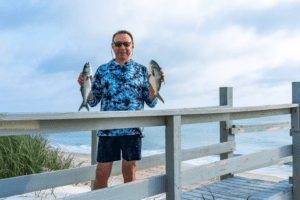
Depending on the environment and conditions, numerous techniques are available to catch pompano. Let’s look at how you can leverage surf fishing, inlet and pass fishing, and flats fishing to land a great catch.
Surf Fishing
Surf fishing is a popular method to catch fish, especially for catching pompano. This involves wading into the surf or casting from the shoreline. The trick is to cast bait or lures where the waves break, as pompano tend to look for food in that rough water. Many anglers fish multiple rods (7 foot rods for active fishing closer to shore and 10+ foot rods for long casts to sandbars past the wave break) this allows an angler to cover more area and maximize the chances of catching a pompano.
When surf fishing, you’ll need a special pompano rig and different baits like live and frozen shrimp, and live and frozen sand fleas. The bait you choose significantly impacts the chances of getting those pompano to bite, making sand fleas a top choice for many anglers.
Inlet and Pass Fishing
Inlet and pass fishing is another effective method for catching pompano. This involves catching pompano in the spots where inlets and passes meet the ocean. These areas are perfect for pompano because they like to hang out there and are often easy to find.
To catch pompano using inlet and pass fishing techniques, you can try:
- Jigging around structures like jetties or piers
- Casting up current and bouncing a jig through sandy spots
- Vertically fishing with jigs as the boat drifts along with the tide.
Flats Fishing
Flats fishing is a preferred method if you’re targeting pompano in shallow bars and grass flats, usually near inlets and passes where long sand bars are present. You can catch them from a boat or from the beach, using a pompano rig with sand fleas or trying out surf fishing methods.
When it comes to flats fishing, be sure to be stealthy as pompano can get spooked easily in shallow waters. Also, remember that water temperature is super important. Pompano like it around 68 degrees, but you can still catch them in temperatures from the low 60s to the high 70s.
Prime Pompano Fishing Locations In Florida

Florida is well-known for its fantastic pompano fishing spots. From the Panhandle to the Atlantic coast up to Jacksonville, you’ll find great opportunities to catch these feisty fish. Some of the top spots for pompano fishing in Florida include:
- Inlets
- Surf zones
- Beaches
- Piers
- Bridges
Some popular beaches for pompano fishing include those along the Atlantic coast, like Cocoa Beach. However, don’t forget to explore less crowded spots as well. The key is to look for spots with sandy beaches, sandbars, and troughs, as these are the places where pompano usually hang out.
Timing Your Pompano Fishing Trip
The success of your pompano fishing trip significantly depends on its timing. In Florida, the best time to catch pompano is between November and February. From March to September, when they spawn and migrate offshore they are less accessible, unless you have a boat. However, the peak fishing seasons can vary by region and water temperature.
Tides also have a big impact on pompano fishing. Here’s why:
- High tide brings the baitfish and other prey closer to shore, making it easier for pompano to find food.
- The currents and rips caused by tides also help gather the baitfish, making it easier for pompano to catch them.
- That’s why fishing during high tide can be really good.
But even when it’s low tide, the fish concentrate in certain areas, making it another good time to catch pompano.
Pompano Fishing Regulations and Conservation
Fishing regulations are designed to protect pompano populations and encourage sustainable fishing. These rules help in maintaining a balance between conservation and fishing activities. These regulations help prevent overfishing by setting size limits and catch limits, allowing the pompano populations to reproduce and stay healthy.
In Florida, there are specific rules and regulations for catching pompano:
- The pompano you catch must be at least 11 inches long.
- You are only allowed to take six pompano per person per day.
- Pompano can only be caught using a hook and line, cast net, or beach or haul seine.
Violating these rules can result in substantial fines and even jail time. So always make sure you’re up to date with the rules and regulations.
Preparing and Cooking Your Pompano Catch
While hooking a pompano indeed thrills, preparing and savoring your catch is no less rewarding. Cleaning and filleting a pompano fish involves:
- Cutting out the little bone near the head
- Removing the pin bones
- Gutting the fish
- Scraping out the kidneys
After that, the fillets can be cooked with the skin on and grilled whole, seasoned as you like.
There are countless ways to cook your pompano, from grilling to broiling. A simple yet delicious way to grill pompano is to squeeze some lemon juice over the fillets, brush them with melted butter, sprinkle some garlic salt and paprika, then grill them for about three to four minutes on each side. If you prefer to broil your pompano, place it skin side up on a buttered broiler pan or sizzle platter and broil for three to four minutes, then flip with a spatula and broil the other side.
Pompano Fishing for Beginners
Pompano fishing is a great choice for beginners. These fish are known for biting well and make fishing fun and easy for those new to the sport. All you need is the right gear, some patience, and a love for the outdoors.
Embarking on pompano fishing necessitates appropriate gear and knowledge. Here are the basic necessities:
- A lightweight spinning rod or surf casting rod with medium action
- A matching spinning reel
- 8-14 lb monofilament or fluorocarbon line
- Size 1/0 or 2/0 circle hooks
- Pyramid or bank sinkers
- Some popular bait like sand fleas and shrimp
But remember, having the right gear and knowing how to use it is only half the battle. It’s equally important to understand where to find pompano, their habits, and the best times to fish.
Summary
There you have it – a comprehensive guide to pompano fishing in Florida. From understanding the behavior of pompano and choosing the right gear, to mastering various fishing techniques and preparing your delicious catch, we’ve covered everything you need to know to get started and be successful in pompano fishing. Whether you’re a beginner or an experienced angler, always remember that fishing is not just about the catch; it’s about enjoying the experience and appreciating the beauty of nature.
Frequently Asked Questions
What is the best bait for pompano?
The best bait for pompano includes live shrimp, sand fleas (mole crabs), and artificial jigs. These are popular and effective choices for catching pompano.
What is the best time to catch pompano?
The best time to catch pompano is during early mornings and late afternoons, especially during incoming tides when they actively feed nearshore or in the surf zone.
What is the best rig for pompano fishing?
For the best pompano fishing rig, use a setup with two or three hooks, beads, floats, and sinkers connected by fishing line, ideally using monofilament or fluorocarbon. Don’t forget a one-to-four-ounce sinker for added effectiveness.
Where is the best place to catch pompano?
The best place to catch pompano is along the Atlantic coast of the United States, from Florida to Virginia, and in the Gulf of Mexico, especially in areas like Texas, Louisiana, and Florida’s Gulf coast. Happy fishing!
What gear do I need for pompano fishing?
You’ll need a lightweight spinning rod or surf rod with medium action, a matching spinning reel, 8-14 lb monofilament or fluorocarbon line, size 1/0 or 2/0 circle hooks, pyramid or bank sinkers, and popular bait like sand fleas and shrimp for pompano fishing. Happy fishing!


